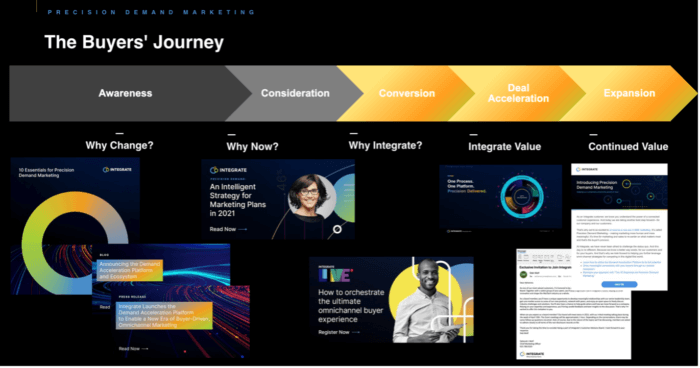The Yin to the Yang: Marketing Operations and Demand Generation Teams
I am not surprised when I hear from Marketing leaders that their biggest roadblocks are due to silos within their organization. This is, unfortunately, more common than most marketing organizations would like to admit.
Friction points have ratcheted up a notch recently as companies are struggling to cram a few years’ worth of digital transformation initiatives into a few months to keep up with their buyer demand.
Departments faced with budget cuts are competing for technology investment from a limited funding pool and there is no question in the current environment budgets are fluid. This can unfortunately set up an us versus them dynamic, and conflicts and silos naturally occur.
What if we stopped talking about our internal processes and we centered our focus on the buyer? I think we all need to ask ourselves, how do our roles shift to become more buyer-centric?
What Causes Misalignment Between Demand and Marketing Operations?
I DO get surprised when I hear there are silos specifically between Marketing Operations (which we affectionately refer to as Marketing Ops or MOPs) and Demand Generation Teams. Primarily because I can’t think of a more critical alignment to drive buyer connections.
So, why do MOPs and Demand Teams tend to be at odds? These teams think very differently.
- MOPs Teams think operationally. Demand Teams think programmatically.
- MOPs Teams think MarTech. Demand Teams think MarTech to enable campaigns.
- MOPs Teams think data. Demand Teams think funnel.
- MOPs Teams think orchestration. Demand Teams think buyer experience.
Forgive the broad generalizations for a moment, but this is what we so often hear, or, even worse, that MOPs Teams think MarTech only and Demand Gen Teams think leads only. If this is not the case in your Marketing department, count yourself lucky, because you’re on the right track.
Yin and Yang
In Chinese philosophy, yin and yang is a concept of dualism, describing how seemingly opposite forces may actually be complementary, interconnected, and interdependent, and how they may give rise to each other as they interrelate to one another.
I can’t think of a more perfect analogy when we see the power of MOPs and Demand teams come together. Because here’s the thing, at the end of the day, if these teams are out of sync, no one wins. Our Integrate Team is lucky to see how the synergy of MOPs and Demand equate to revenue generation both within our own team as well as and with our B2B marketing customers.
I have been fortunate to work with our Senior Director of MOPs, my colleague and friend, Danny McKeever, for many years and across four companies. We have learned much from one another over the years, although it is still safe to say that Danny and I (and our teams) look at things differently. But, we have the same end goal — driving revenue together.
To get a feel for the Marketing Operations functions and lens, check out Danny’s recent blog, A 90 Day Plan for Marketing Operations, where he talks about five key things MOPs must do in service of providing intelligence back to the business:
- the criticality of getting your data right
- connecting your demand channels
- adding data intelligence
- the importance of MarTech integrations
- delivering campaign insights
The Demand Team must also care about all of those things as well because:
- If you don’t have confidence in the data, how can you drive personalized experiences to your buyers or key segments?
- If your demand channels are not connected, how can you orchestrate buyer and account journey’s in their preferred channels?
- If you don’t have data intelligence, how can you ensure your SDR and Sales Teams prioritize the right buyer at the right time through intent indicators and lead scoring?
- If you don’t have campaign insights, how do you know which channels and campaigns are your highest performing to further invest, and deprioritize those that are underperforming?
The data tells us the story.
Finding Harmony
When does harmony happen? When we all focus on the buyer’s journey.
- When your data is accurate, your buyer has a personalized, contextual experience.
- When your channels are connected, you interact and connect with your buyer in their channels.
- When you have data intelligence, you engage with your buyer in the way they want to engage.
- When you have campaign insights, you meet your buyer where they are.
Today’s Challenging Landscape
According to Twilio research, the pandemic has accelerated most companies’ digital communication strategy by six years. Meanwhile, McKinsey reported that in just three months of 2020, US eCommerce penetration grew as much as it has in the past ten years. And this global economy shift has dramatically impacted the marketing landscape right along with it.
Bombora estimates that there are only a maximum of 15% of your target accounts “in market” for what you sell at any given point. SiriusDecisions | Forrester research says that the average B2B buying group consists of 8-12 active personas. What’s more, they’re all researching independently and well over halfway through their purchase decision before engaging a sales rep.
All of these stats underscore how complicated the B2B landscape has become and the importance of personalized, empathetic digital interactions to win over buyers. Today, marketers are facing increasing pressure to scale our impact on revenue. And with customer expectations rising, it’s no surprise that marketers agree they see a dramatic increase in new customer acquisition because of personalization.
Internalizing the Buyers’ Process
To personalize your interactions with buyers, you must have access to data intelligence that helps you understand their current landscape. Where are they in their buying journey? What are they looking for? What problem are they trying to solve? Are they researching my products right now?
When you think about it, only ONE process matters – the buyer’s process – and it’s, unfortunately, wreaking havoc on Marketers’ pipelines. This ever-changing process exacerbates the challenges of getting clean, intelligent, and actionable leads predictably and at scale, because most B2B Marketers are not aligned with their buyers. They simply do not have the data intelligence necessary to provide the buyers’ expected experience. With increasing reliance on digital experiences that guide and influence purchasing decisions, it will be challenging to advance your marketing and sales efforts without focusing on the buyer’s experience.
Easier said than done, right? Being buyer-driven requires strategic thinking on reaching the right accounts, the right buying committee, and the right champion for your solution. We also know all too well as marketers this is not achievable without orchestration. Aligned with our MOPs friends, we orchestrate journeys based on Account to Demand Unit to Individual. And the critical element in the equation are the carefully thought-through service-level agreements (SLAs) with our Sales and Inside Sales Teams to achieve the experience we want all of our buyers to have.
See a sample Buyer’s Journey below to spur your thinking:

Embracing the Buyers’ Process
We get it, the B2B sales cycle is complex. We will have to pivot to what we call Precision Demand Marketing if we hope to survive in the buyer’s world. In Sales and Marketing, we know if we don’t get it right, our competition will.
The logical next question may be, so where do I start? Check out the 10 Essentials for Precision Demand Marketing thinking and look for more ways to partner with MOPs to orchestrate your buyer’s journey in my upcoming Buyers’ Journey Blog Series. I love the thinking because it gives us a call to arms to better serve our buyers and concrete actions to take. We all want harmony within our organizations and with our buyers. The pursuit continues to break down roadblocks to revenue because we know…
The buyer tells us the story. We just have to listen.









